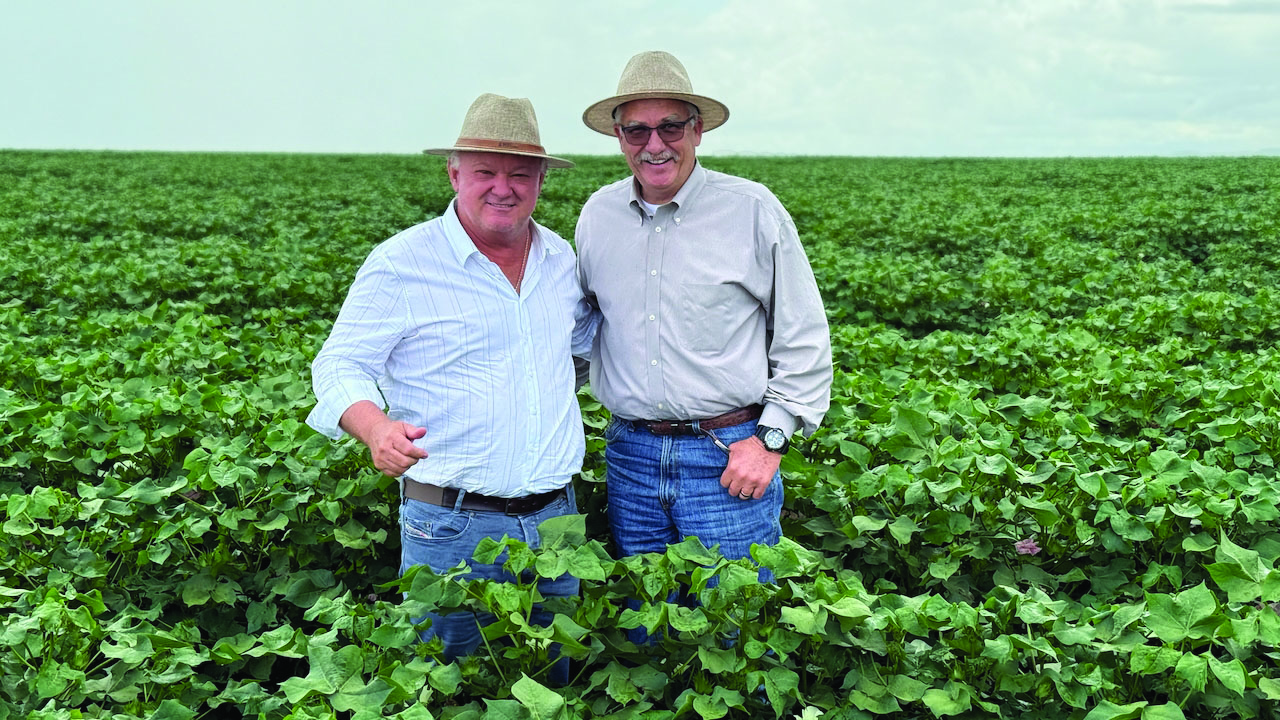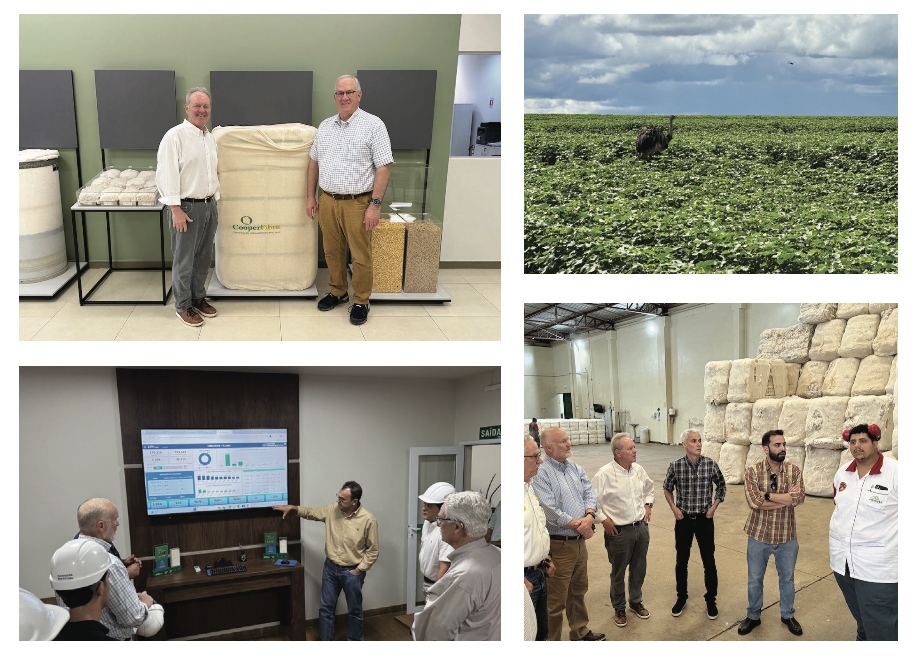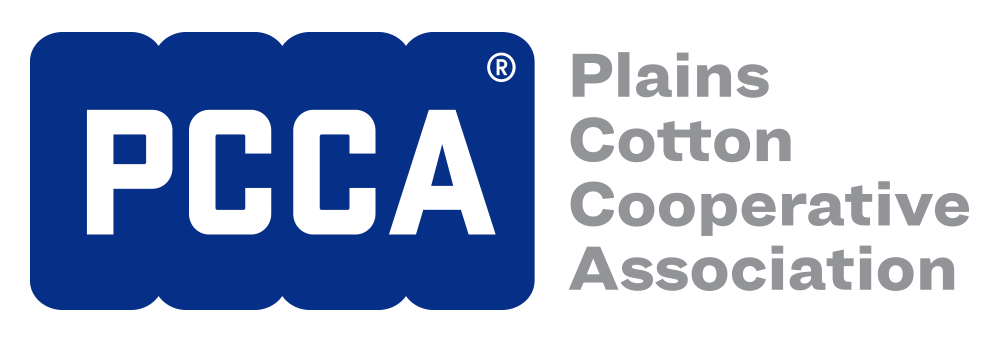Fact, Fiction and the Future of Cotton | What We Learned About Brazil’s Cotton Industry
by Kevin Brinkley, PCCA President & CEO
 In April 2025, Kevin Brinkley, PCCA Chairman Dahlen Hancock, Keith Lucas, and Jay Cowart traveled to Brazil to explore its cotton industry firsthand. Their objective: better understand Brazil’s strengths and challenges—and identify ways U.S. growers can collaborate with global counterparts to compete more effectively against synthetic fibers.
In April 2025, Kevin Brinkley, PCCA Chairman Dahlen Hancock, Keith Lucas, and Jay Cowart traveled to Brazil to explore its cotton industry firsthand. Their objective: better understand Brazil’s strengths and challenges—and identify ways U.S. growers can collaborate with global counterparts to compete more effectively against synthetic fibers.
Spend five minutes talking cotton with a U.S. grower and you’ll eventually hear the name “Brazil.” It usually comes with a mix of awe, confusion, and concern. Over the years, a steady drip of assumptions, half-truths, and anecdotes has shaped our perception of Brazil’s cotton industry—sometimes accurate, often not. In April, I joined a group of PCCA leadership on a firsthand tour of Brazil’s production regions, infrastructure, co-operatives, and research centers. What we found was both surprising and sobering. Brazil is not the boogeyman. It’s not a threat to be wished away. It’s a global competitor—and in many ways, a mirror—showing us where we excel and where we must improve. Let’s bust some of the biggest myths we encountered.
Myth #1: Brazil is destroying the rainforest to plant cotton.
The reality is that most of Brazil’s cotton is grown on land that was previously used for pasture. Stringent environmental laws require at least 25% of a farm to remain in native vegetation, and violations carry serious penalties. Cotton’s expansion in Brazil has come not at the cost of forests, but by replacing cattle ranching with more economically viable crops like soybeans, followed by safrinha corn and cotton.
Myth #2: Brazilian cotton farmers use cheaper equipment and technology.
Walk onto a large Brazilian cotton farm and you’ll see brand-new John Deere CP770s—some costing $1.5 million. These machines aren’t governed by U.S. emissions rules, but that doesn’t make them less advanced. In fact, removing U.S.-specific emissions controls actually adds cost for Brazilian buyers. Many farms also use cutting-edge software, GPS, and analytics platforms that rival what’s available in the U.S.
Myth #3: They don’t classify cotton like we do.
False. Nearly every bale in Brazil is classed using HVI systems. Their national cotton organization, ABRAPA, operates a centralized digital database that is populated with data from certified classing labs. Each bale is tagged with a QR code that includes classing results and source information, right down to the field. However, unlike U.S. cotton, the Brazilian government doesn’t operate the facilities; ABRAPA members do. USDA is the global standard in objective cotton classing.
Myth #4: Brazil doesn’t have our pest pressure.
They wish. Brazilian farms contend with a gauntlet of pests—boll weevils, aphids, bollworms, and more. The average farm sprays 15 to 27 times per season. Beneficial insect populations are low, and resistance management is an ongoing challenge.
Myth #5: Brazil undercuts the U.S. by using cheap labor and currency tricks.
The exchange rate may benefit Brazilian exporters, but it cuts both ways. Farmers purchase inputs in advance—often two years before harvest—and those are priced in current dollars. Their forward-selling model isn’t a cheat code; it’s a risk strategy.
Myth #6: Brazil’s cotton bale packaging is a significant competitive advantage.
Some in the U.S. believe Brazil has solved the problem of plastic contamination by using different bale bags. The truth is more complicated. Brazil often uses nonwoven, flimsy cotton bale wrap resembling gauze that can shred with minimal handling. In fact, contamination concerns still exist—many Brazilian bales are tied with metal wire, which has drawn complaints from mills due to safety, rust, and debris. While packaging may differ, it’s not necessarily better—and it’s certainly not a game-changer.
Myth #7: Brazil’s infrastructure is too poor to move cotton effectively.
Brazil’s roads are often congested and overcapacity. Rail options are limited, but despite the logistical challenges, Brazilian growers and merchants have built a functional system. Cotton moves from the interior to ports and returns with fertilizer in backhauls. They don’t have the infrastructure we do, but they’ve figured out how to make it work, and they keep improving.
Myth #8: Brazil is trying to put U.S. cotton out of business.
Brazilian farmers aren’t out to get us. They’re doing what any of us would do: responding to market signals. The real enemy isn’t Brazil. It’s synthetic fiber. If cotton is to reclaim lost market share, there’s plenty of room for both U.S. and Brazilian growers.
Myth #9: Brazil’s rise means the U.S. cotton industry is done.
Not even close. Brazil will be a force for decades to come, but it doesn’t signal the end of U.S. cotton. What it does signal is a challenge—a call to action. U.S. yields have stagnated while Brazil’s have improved. We’ve got the land, the people, and the know-how. Now we need the innovation and investment to match.
There’s a temptation to view global competition as a threat. But pretending Brazil’s success is built on shortcuts or unfair advantages only holds us back. It’s time to move past the myths and focus on facts. Because in this story, the ending isn’t “us or them.” The ending—if we get it right—can be “us and them,” growing cotton’s global footprint together.


